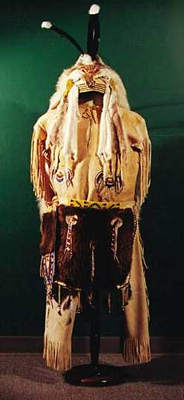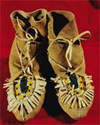
 |
| Traditional Man's Clothing |
The Secwepemc territories are hot in the summer and cold in the winter so a wide variety of clothing was needed throughout the year.
Most clothing was made from animal skins, but some plant fibers were also used. Occasionally, fiber made from bark was used for clothing, but it was not common.
The basic clothing for men was buckskin leggings or pants, shirt and moccasins. The leggings were sewn with sinew or tied using buckskin strips. Shirts were the pullover type with a slit for the neck. No great attention was paid to the decoration of the clothing. Ponchos, capes or coats were also used.
The basic clothing for women was a straight cut buckskin dress and moccasins. Fringes were the main decoration.
|
Footwear: Moccasins, slippers and mucklucks were usually made from tanned elk hides because of its thickness and durability. One style of moccasin was the wraparound style at mid-calf level. The tongue is sewn down the middle, thus the hide is gathered to form a more pointed toe effect.
|
Tanned deer hides were the most common material for making clothing. Deer hide is thinner and more supple than other animal skins. Elk hides were used to make cloths for colder weather because they had thicker hides. Fur was also used.
Older men wore fur caps or headbands. Some were decorated with fur, shells, animal teeth, hair tassels or feathers. Older women wore fringed buckskin caps decorated with quills. Mittens were worn in the winter with the fur side in. Sometimes furs were used to make socks, which were worn the same way. Buckskin gloves were commonly used.
Sometimes clothing was bartered from tribe to tribe, or won in games when members of one tribe gambled with those of another. Skin garments by the Thompson, Okanagan and Kootenai tribes were occasionally found among the Secwepemc. Cree clothing also found its way to the North Thompson River through intertribal trade.
|
|

